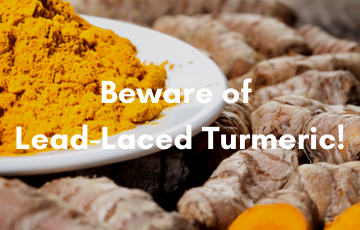
Beware of Lead-Laced Turmeric!
Known worldwide for its bright orange color and vibrant aroma, turmeric has been used for centuries as a beneficial medicinal herb and delicious spice. This root contains compounds known as curcuminoids, which have antioxidant properties and help support a healthy inflammatory response. Medicinal research into the benefits of turmeric have led to its widespread use in supplements and superfoods. However, illegal and unethical manufacturing practices may be tainting this powerful root with a damaging neurotoxin – lead chromate.
A recent study researchers at Stanford University uncovered a damaging truth – many turmeric manufacturers in Bangladesh have been treating the spice with lead chromate. Researchers found that the practice began after damaging floods in the 1980s that resulted in a poor turmeric harvest. The dull herbs after this harvest were brightened with lead chromate, a profoundly toxic chemical compound.
Researchers conducting the study looked at a chemical analysis of 524 turmeric, pigment, dust, and soil samples from Bangladesh. This analysis revealed lead concentrations in excess of 500 times the national limit for an average of 690 micrograms of lead per gram of turmeric. This illegal adulteration was found to be taking place at seven of the nine major turmeric-producing areas in Bangladesh.
Lead is a neurotoxin, meaning that it has significant damaging effects on the nervous system when inhaled or ingested. Lead chromate is known to be a human hazard and has severe health implications after chronic exposure, including kidney damage, impaired eyesight, and Central Nervous System (CNS) damage. Senior author Stephen Luby explained that “unlike other metals, there is no safe consumption limit for lead, it’s a neurotoxin in its totality.”
Lead chromate, which is commonly used to make paint, has a bright yellow hue. This color is coveted in turmeric because it makes curries more vibrant. Manufacturers quoted in the study alleged that they were able to increase profit margins by selling poor quality turmeric root that had been tainted with the bright yellow pigment from lead chromate.
Researchers were unable to determine how widespread this practice was. There is currently no direct evidence of adulterated turmeric outside of Bangladesh. Food safety checks by importing countries may protect some consumers from this harmful practice. Strict health and safety guidelines and more stringent testing may further deter manufacturers from adulterating their turmeric.
“Despite the researcher’s inability to find direct evidence through public records this has been an ongoing problem for years,” says Quantum Nutrition Labs’ Chief Operating Officer and in-house cGMP and Quality testing expert Nickolas Labinsky. “In 2012 we received 3000 kg of whole turmeric root from India and it tested at 1610 ug of lead per gram. Upon confirmation of this result, we rejected this lot back to the vendor. The frightening realization for me was that the tainted lot most likely was shipped to another manufacturer who was not testing for lead and someone was probably eating that lead tainted Turmeric. With the fact that less than 20% of the industry is testing their supplements you should be cautious from who you purchase from. Since the beginning of cGMP, our practice at Quantum Nutrition Labs has been to test all raw material lots that we have received for heavy metal analysis through a statistical sampling plan,” says Nickolas Labinsky.
Safe sourcing of this superior spice is critical to receiving all of its benefits. Importers of turmeric should thoroughly test the material for heavy metals including lead to ensure that their product is not adulterated with this neurotoxin. Consumers should be sure to purchase from a trusted source if they are regularly consuming turmeric or a turmeric-based supplement.







